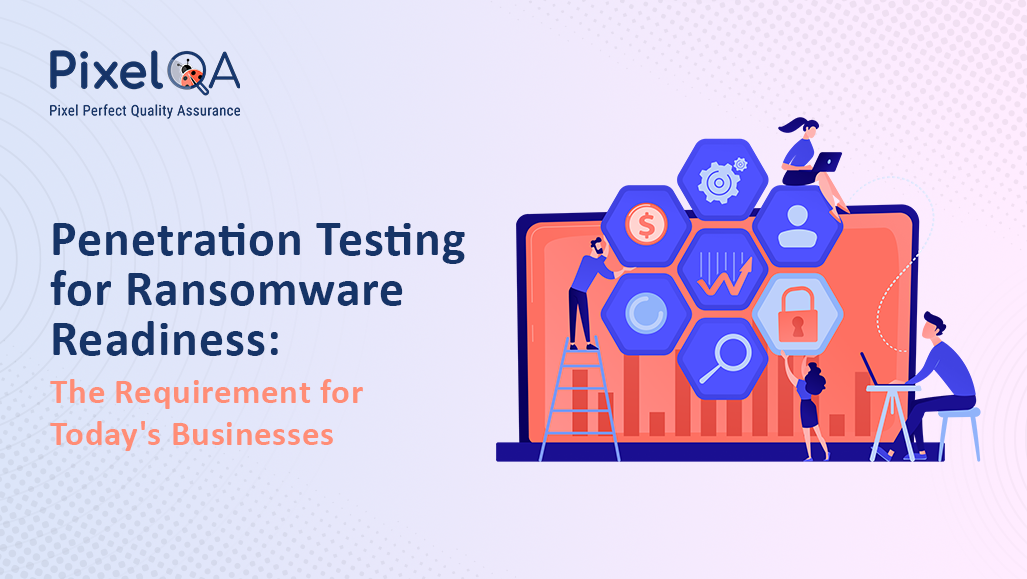
As it is in our modern, fast-changing digital era that cyberattacks have become more unsafe and destructive by the day, some of its most dangerous-looking attacks are the ransomware variety, which experienced an exponential hike over the recent two years or so. In the case of a ransomware attack, whereby hackers encrypt a victim's data and ask for a ransom for the decryption password, a deep disruption in the running of one's business affairs follows.
As ransomware attacks become a more common issue, companies must be proactive and protect themselves against such attacks. Perhaps the most effective way to be prepared and prepared to guard against ransomware is by way of the implementation of penetration testing, or what is more commonly referred to as ethical hacking. To find weaknesses in a company's infrastructure before malicious attackers get the opportunity to exploit them, penetration testing simulates real cyberattacks.
We'll examine how penetration testing services can help companies assess their preparedness for ransomware and harden their defenses against these destructive attacks in this blog post.
Table of Content
- What is penetration testing?
- Why Is Ransomware a Growing Threat?
- How to Become Aware of Ransomware Attacks Through Penetration Testing
- Conclusion
What is penetration testing?
Penetration testing (pen testing) is a replica, repeatable cyberattack that verifies the defense of a system, network, or program. It is intended to ascertain areas of vulnerability, which might be used by an attacker, and to provide recommendations to remediate vulnerabilities before actually being attacked.
There are numerous ways penetration testing can be conducted:
External Pen Testing: Testing as if from an external attacker trying to compromise the defenses of the organization.
Internal Pen Testing: Mimicking an insider attack or a hacker with existing access to the network.
Web Application Testing: Targeting vulnerabilities of web applications such as login pages, APIs, and databases.
Social Engineering Testing: Evaluating human behavior-related vulnerabilities such as phishing or pretexting.
Pen testing provides companies a clear view of their security posture, and specifically applied to ransomware readiness, it can test real-world-like ransomware simulations to find prospective vulnerabilities.
Why Is Ransomware a Growing Threat?
Ransomware, which is malicious malware, encrypts or locks a user's files or system and requests payment, usually in the form of cryptocurrency, to release it. The heightened sophistication of attack methods and the hefty financial rewards hackers can reap from successful intrusions are the primary reasons behind the recent spike in ransomware attacks, say cybersecurity officials.
They involve data exfiltration, with attackers stealing valuable information first, encrypting it, and threatening to leak it in public if payment is not made. Some ransomware also includes business-critical systems, crippling operations and bringing huge monetary losses.
This is how scary ransomware is:
- Cost Effect: Apart from the actual ransom, companies are also paying for downtime, lawyers' fees, and reputation damage costs.
- Damage to Reputation: If a ransomware attack leaks sensitive client details or causes service outages, a firm's reputation can suffer drastically.
- Data Loss: Crucial information might be lost irretrievably from ransomware attacks without backup tools.
Another effective method for detecting vulnerabilities that ransomware professionals can leverage is penetration testing.
How to Become Aware of Ransomware Attacks Through Penetration Testing
Penetration testing is yet another valuable method of detecting vulnerabilities that ransomware professionals could take advantage of. In a controlled environment, companies can test a ransomware attack to discover precisely how a hacker can gain access to their system, what security measures are in place, and where vulnerabilities remain.
Penetration testing can assist companies in preparing for ransomware attacks in the following meaningful ways:
1. Identify Weak Entry Points
Ransomware attackers often exploit a company's security vulnerabilities, such as unpatched software, open remote access points, or poor passwords, to gain entry into a network. By targeting these vulnerabilities, penetration testing can simulate an external attack and assess whether an attacker might gain first access.
For example, ethical hackers might do the following during a pen test:
- Take advantage of operating system or application software's unpatched vulnerabilities.
- Employees can be manipulated into downloading dangerous files or get their login passwords stolen through phishing attacks.
- Make use of technology like brute-force attacks to evaluate poor password controls.
Companies can act quickly in protecting their systems before ransomware attackers have time to exploit these vulnerabilities by learning about these vulnerability points.
2. Assess data recovery processes and backup systems.
Making sure data can be quickly and easily recovered if the system is compromised by any ransomware attack. Penetration tests, or simulated ransomware attacks, are frequently carried out by security experts to determine how well an organization's backup procedures and disaster recovery plans function in real-life scenarios.
Effective penetration testing in this area can:
- Test if backup systems are well isolated from the network so that they will not be encrypted during an attack.
- Make sure that backup data is updated on a regular basis and stored securely.
- Test the integrity of backups by trying to restore data from backups in a test environment.
Businesses may make sure they can swiftly restore the data without having to pay the ransom by testing such recovery procedures.
3. Test Endpoint Security
Ransomware commonly spreads through compromised endpoints like desktop computers, cellphones, and employee-operated laptops. By checking for whether firewalls, antivirus applications, and other protection features function as designed, penetration testers can determine the organization's endpoint defenses.
Pen testers could include
- Test whether malware detection software can catch ransomware payloads before they execute.
- Check to see if endpoint devices have the most recent security patches installed and patched correctly.
- Run phishing simulations to see if staff members click on risky links that could lead to ransomware attacks.
Businesses can stop ransomware from infiltrating the system through these popular attack channels by fixing endpoint vulnerabilities.
4. Assess Incident Response Plans
To reduce the harm caused by a ransomware attack, a strong incident response plan (IRP) must be in place. Penetration testers can assist in determining how quickly and successfully a business can react to a ransomware assault scenario.
Some of the most important components of an incident response plan are listed below:
- Detection and Identification: Early detection that an attack is in progress.
- Containment: Isolating the spread of ransomware across the network.
- Eradication:Elimination of harmful files from the network.
- Communication: Working with internal departments, third-party suppliers, and perhaps even law enforcement.
Pen testing will evaluate these components by simulating an attack and seeing how quickly the company can respond and contain the threat.
5. Measure Employee Awareness
Even the most advanced technological shields will not suffice if employees themselves do not know how to detect phishing emails or suspicious links. Penetration testing may involve social engineering techniques to measure employee awareness and resistance to attacks
Pen testers might:
- Send phishing emails with malicious attachments to see how employees respond.
- Test security training by attempting to manipulate employees into revealing sensitive information.
- Simulate ransomware via email to determine if employees identify the risk and respond correctly.
Employee training and awareness are a necessary part of any ransomware defense plan, and pen testing can identify areas where efforts are required.
Conclusion:
Companies need to be proactive and aware of current ransomware attacks because ransom attacks are rising every minute in different ways. Here, you can read mentioned points that may help companies to stay more secure.
By mimicking actual ransomware situations, companies can:
- Discover vulnerable entry points that attackers could take advantage of.
- Test the efficacy of backup and recovery systems.
- Myosotis is testing endpoint security and incident response capability.
- Test employee preparedness to handle social engineering attacks.
Lastly, penetration testing gives businesses a clear report on their readiness against ransomware.
About Author

Rushi Mistry is a Security Analyst at PixelQA with a focus on cybersecurity. He is passionate about IoT penetration testing and is working towards obtaining a CISSP certification, with the ultimate goal of becoming a Chief Information Security Officer (CISO).

_638828877893233294.png)